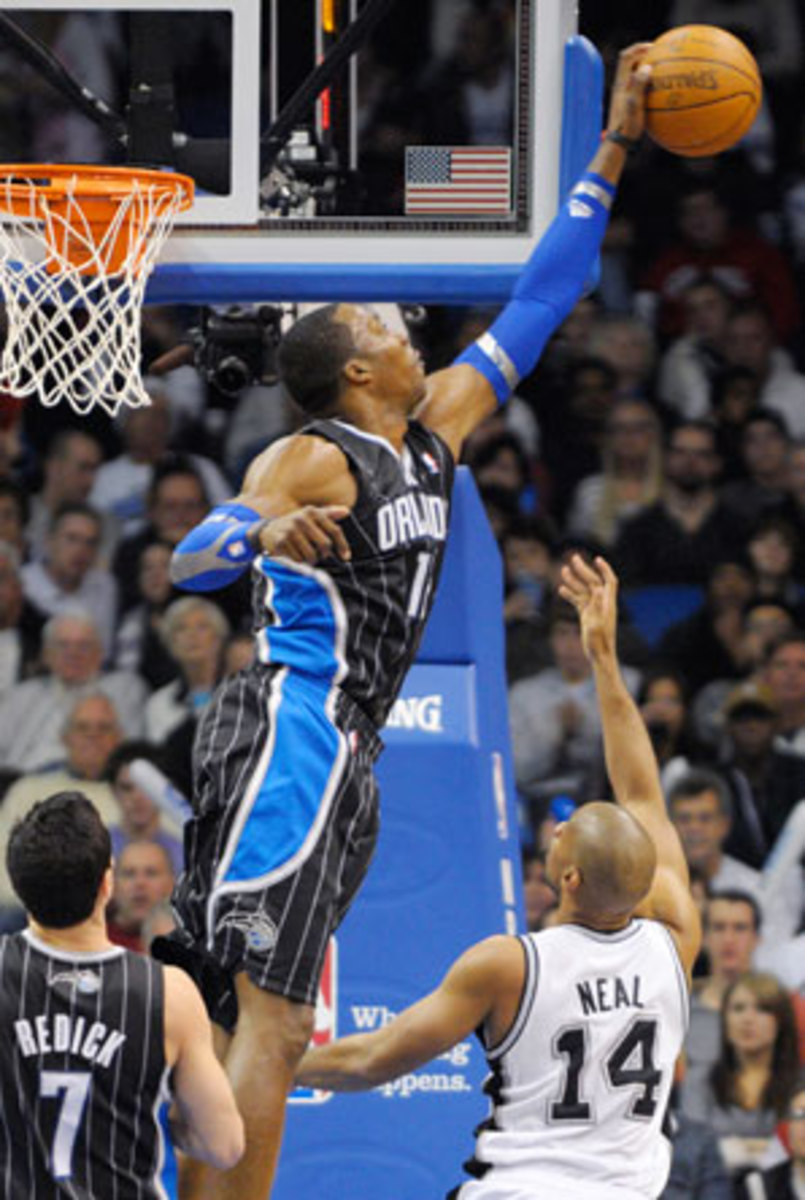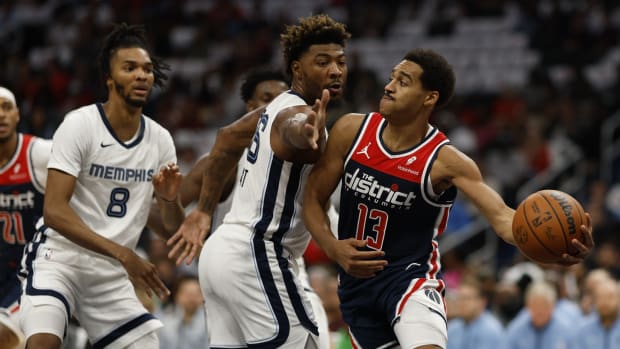Time to take advanced defensive stats to next level in basketball
These are strange times in the world of basketball analytics.
The momentum, prevalence, and public comprehension of advanced stats and their goals have never been higher. Sports analytics are on TV, in movies and in video games, and though the casual consumers of the NBA haven't always been totally receptive to them, they can no longer be ignored. Like it or not, advanced stats, in some form, are pretty much everywhere, and they do a great deal to guide a lot of today's basketball decision-making and discourse.
But while there's plenty of innovation within the NBA's analytic community, it feels as though the movement (if you can call it that) has reached a crossroads: There are various measures that gauge offensive value and worthwhile lineup metrics, but there's still a considerable gap between where the research is now and where it, ideally, needs to go. That gap is often addressed vaguely or with a sense of defeatism, but the analytic collective should instead take aim for what should -- and can -- be the next stage in the movement's progression: defensive analytics.
The precision of baseball's sabermetrics era has spoiled us. The goal of basketball analytics was never to create the perfect stat, but merely to find ones that add to our current knowledge. We rely on imperfect stats to measure offensive production all the time, and we manage the weaknesses of those flawed metrics by clarifying their context. But the burden of proof seems to be much higher for defensive statistics than offensive ones, with any newly constructed defensive measure quickly dismissed on the basis of its imperfection.
Granted, there's no question that advanced statistics in basketball lag in adequately assessing a player's defense -- one of the more prominent parallels in basketball analytics and early sabermetrics. Efforts to quantify defense have improved in recent years, but on the whole, offensive metrics are both more reliable and more refined.
The reason for this is relatively simple: Although all 10 players on the court impact the course of a given possession, the scoring events of such a series are documented explicitly. Basic counting stats like points and assists may not be completely reliable in themselves, but they provide a foundation for creating more descriptive measures of player value and performance. Steals, blocks and defensive rebounds, on the other hand, give some indication of how a particular player performs on defense, but not a particularly exact one.
How, then, can statisticians even begin to make strides in analytical defensive work? The key lies in continuing to expand the methodology of contemporary defensive metrics. Opponent Player Efficiency Rating (PER), which measures the per-minute production of a given player's positional opposite while adjusting for pace, and individual defensive rating, which charts the per-possession defensive performance of a team while a certain player is on the court, are two examples of useful defensive measurement derived from non-box score data. The public release of game logs opened the door for plus-minus analysis (which estimates a player's impact on a the game) and the manipulation of lineup data, all while the standard box score continued to hold its same fundamental limitations.
Sure, it would be great if the NBA would update the traditional box score to include a more comprehensive survey of defensive impact, but waiting on that to happen would set the evolution of analytics back even further. Rather than focus on what is or isn't made available in the box score, statisticians should concentrate on identifying exactly what information is needed to formulate a more accurate defensive vision and then devise a way to obtain that information. The future doesn't lie in formally expanding the box score, but in finding more ways to render it obsolete.
One-number metrics are great for broad comparisons, but they tend to miss the mark in illustrating performance. While it may be useful to know if one player contributes more than another in a general sense, basketball is a complex game of interlocking skills that inherently make single, self-standing metrics less meaningful. The true strength of analytics lies not in a focus on an individual metric, but in tethering together micro-level measures to create a comprehensive overview of player performance.
This is particularly true on the defensive end, where focused analytics can help us to better understand the intricacies of defensive play. As it stands now, defense is observed but greatly influenced by reputation; once a player becomes known as a "lockdown defender," even subpar play won't discredit his standing. General managers, fans and even other players are guilty of confirmation bias, often unknowingly affirming what they already believe about the defensive ability of a certain player, unconsciously ignoring contrary evidence in the process.
The further creation of specific, small-scale defensive analytics would allow us to understand individual defensive play on a more exact level, and analyze the assumptions we make about specific defensive ability and its impact on the game as a whole.
Take rebounding, for example. By looking at a player's defensive rebounds per game, we get a general idea of how well he works the glass. But we could break down that single number into much more descriptive measures. How many of a player's rebounds are contested? How is a player's rebounding affected by the height of his opponent? What is the success rate of a player's box-out technique? How often will a certain player grab rebounds outside of his immediate area? Does a particular player rebound jump shots more effectively than layups? All of those questions can be answered with simple, conceivable statistical measures.
That level of detail may seem inconsequential, but it's helpful in creating a more accurate view of individual strengths, weaknesses, and -- by extension -- impact on a team's performance. There are tons of defensive elements to account for, most of which have yet to be properly measured. Once those elements are made tangible, we'll have a far more accurate view of who defends well and how much his team actually benefits from it.
Naturally, the process of quantifying the many aspects of individual defense is hardly simple. A glaring problem: Even when accounting for alternative streams, most of the readily accessible sources of data have already been explored. We've scoured the box score. We've generally figured out the best ways to manipulate game logs and lineup data. We've worked and re-worked the same numbers, and it's become abundantly clear that the next analytic evolution will need to be drawn from a new well.
The most pragmatic base for such an evolution: the growing world of third-party data collection.
Synergy Sports Technology, for example, already has the infrastructure to log shot types, shot-clock variables, defensive pressure, position on the floor, defender response and much more. Would it be so difficult to add a few more defensive elements, if only to give the numbers we already have the appropriate clarity?
Plus, SportVU -- the player tracking service maintained by STAT, LLC -- is poised to rock the boat with all kinds of raw, quantitative measures previously considered impossible to track. Defensive player separation and average player speed are just two examples from the wealth of information that SportVU can (and will) provide; the possibilities for metric analyses explode with this kind of technological innovation.
With the framework of those services in mind, here are a few defensive measures that could be tracked without considerable effort, along with some simple, conceptual stats that could be produced as a result:
• Deflections: They demonstrate a player's defensive activity level and often break up play action without being formally credited as a steal.
• Hedge rate: Assessing pick-and-roll defense in statistical form is difficult because of systemic considerations, but quantifying how often -- or how far -- a player hedges to counter a screen would provide an added level of defensive specificity.
• Gambles and gambling ratio: Steals are great, but there's an inherent risk in creating them. Charting the times that a player sacrifices position for a steal attempt would be valuable, and as a result we could create simple ratios based on the success/fail rate of steal attempts.
• On-ball plays vs. off-ball plays: Creating a simple logging distinction between an on-ball block and an off-ball block would add a new dimension to basic counting stats.
• Optimal defensive spacing: Optical tracking technology would allow analysts to break down the best defensive formations for dealing with particular players or lineups. (For example: What impact does a defender playing off of Rajon Rondo have on the Celtics' offense? How far can a defender sag into the paint without being burned by Boston's ball movement?)
• Steal-plus and block-plus: A combination of steal/block stats and fast-break points that credits defenders for creating and capitalizing on turnovers. Some players are more adept than others at keeping a blocked shot inbounds or turning a steal into a fast-break bucket; that's information worth having, and thus, worth logging.
• Close-out variation: Some shooters are more bothered by having a hand in their face than others. What's the optimal distance a defender needs to maintain in order to best challenge a particular player's release?
With next-level data collection in sight, we're now inching toward our metric future: a world of detailed, hyper-specific micro-statistics crafted to give us as much useful information as possible. Those statistics won't be perfect -- numbers in basketball never are. But they'll finally offer the reliable quantitative component that defensive assessment has never had, and foster a more complete comprehension of defensive play for fans, coaches and executives.




































